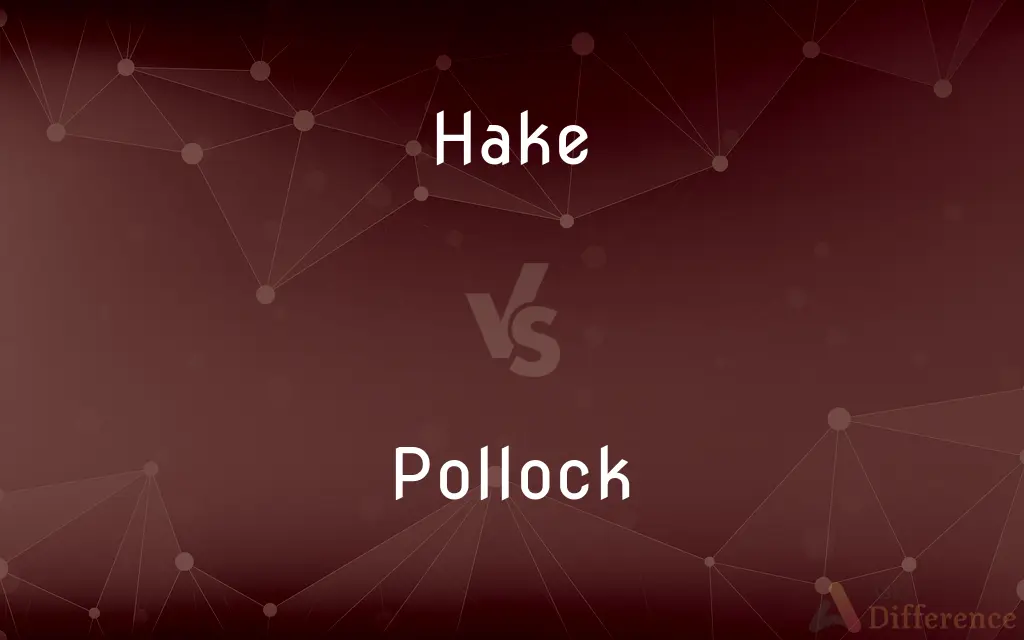Hake vs. Pollock — What's the Difference?
By Fiza Rafique & Urooj Arif — Updated on March 29, 2024
Hake and Pollock are both popular fish in culinary uses, with Hake being milder in flavor and softer in texture, while Pollock is known for its firmer texture and stronger taste.

Difference Between Hake and Pollock
Table of Contents
ADVERTISEMENT
Key Differences
Hake is a fish belonging to the cod family, known for its mild flavor and soft, delicate texture that makes it a favorite in various cuisines. Whereas Pollock, also a member of the cod family, offers a more pronounced taste and a firmer texture, often preferred for recipes requiring more robust fish.
Hake thrives in deeper, warmer waters and is commonly found in the Atlantic and North Pacific. On the other hand, Pollock is typically associated with colder, Arctic waters, especially in the Northern Pacific and the North Atlantic, influencing their habitat-based availability and culinary uses.
In culinary contexts, Hake is often celebrated for its versatility, easily taking on the flavors of ingredients it’s cooked with, making it suitable for a wide range of dishes. Pollock, however, is frequently utilized in processed food products like fish sticks and surimi, where its stronger flavor and dense texture are advantageous.
The market demand for Hake is driven by its popularity in European countries, particularly Spain and Portugal, where it's a staple in traditional dishes. Conversely, Pollock has found its stronghold in the fast-food industry, especially in the United States, as the primary fish used in sandwiches, due to its cost-effectiveness and consistent quality.
Sustainability practices also differentiate these species; Hake fisheries are often subject to stringent regulations to prevent overfishing and promote environmental stewardship. Pollock, while also managed for sustainability, has faced challenges due to high demand, leading to more aggressive fishing practices.
ADVERTISEMENT
Comparison Chart
Flavor
Mild, delicate
Stronger, more pronounced
Texture
Soft, flaky
Firmer, denser
Habitat
Deeper, warmer waters of the Atlantic and North Pacific
Colder, Arctic waters of the Northern Pacific and North Atlantic
Culinary Uses
Versatile, suited for a wide range of dishes
Often used in processed foods like fish sticks and surimi
Market Demand
High in European countries, especially Spain and Portugal
Strong in the fast-food industry in the United States
Compare with Definitions
Hake
A mild-flavored, soft-textured fish from the cod family, often used in European cuisine.
Hake is a popular choice for traditional Spanish seafood dishes.
Pollock
Thrives in colder waters, making it a staple in certain fisheries.
Pollock fisheries in the North Pacific are among the world’s largest.
Hake
Prized for its versatility in cooking methods.
Hake can be baked, fried, or poached, depending on the recipe.
Pollock
Favored for recipes requiring a more pronounced fish taste.
Pollock holds up well in bold, spicy dishes.
Hake
Commonly found in warmer waters, influencing its availability.
Hake caught off the coast of Portugal is a staple in local diets.
Pollock
Managed for sustainability, despite challenges from high demand.
Pollock quotas aim to prevent overfishing while meeting global needs.
Hake
Known for its delicate taste, making it suitable for subtle seasoning.
Lightly seasoned hake with herbs highlights its natural flavors.
Pollock
A fish known for its firmer texture and stronger flavor, common in American fast food.
Pollock is the go-to fish for many fish sandwiches.
Hake
Subject to sustainable fishing practices to ensure its future availability.
Regulations ensure hake populations remain healthy and plentiful.
Pollock
Often used in processed food products due to its dense texture.
Pollock is a key ingredient in many brands of fish sticks.
Hake
The term hake refers to fish in the:
Pollock
Pollock or pollack (pronounced ) is the common name used for either of the two species of North Atlantic marine fish in the genus Pollachius. Pollachius pollachius is referred to as pollock in both North America and the United Kingdom, while Pollachius virens is usually known as coley in the British Isles (derived from the older name coalfish).
Hake
Any of various marine food fishes chiefly of the genera Merluccius and Urophycis, closely related to and resembling the cods.
Pollock
Any of various marine food fishes of the genera Pollachius and Theragra, closely related to the cod, especially T. chalcogramma of northern Pacific waters, often used for manufactured fish products.
Hake
A hook; a pot-hook.
Pollock
Either of two lean, white marine food fishes, of the genus Pollachius, in the cod family.
Hake
A kind of weapon; a pike.
Pollock
To fish for pollock.
Hake
(in the plural) The draught-irons of a plough.
Pollock
To splatter, as with paint.
Hake
One of several species of marine gadoid fishes, of the genera Phycis, Merluccius, and allies.
Pollock
A marine gadoid fish (Pollachius carbonarius), native both of the European and American coasts. It is allied to the cod, and like it is salted and dried. In England it is called coalfish, lob, podley, podling, pollack, etc.
Hake
A drying shed, as for unburned tile.
Pollock
United States artist famous for painting with a drip technique; a leader of abstract expressionism in America (1912-1956)
Hake
To loiter; to sneak.
Pollock
Lean white flesh of North Atlantic fish; similar to codfish
Hake
A drying shed, as for unburned tile.
Pollock
Important food and game fish of northern seas (especially the northern Atlantic); related to cod
Hake
One of several species of marine gadoid fishes, of the genera Phycis, Merlucius, and allies. The common European hake is Merlucius vulgaris; the American silver hake or whiting is Merlucius bilinearis. Two American species (Phycis chuss and Phycis tenius) are important food fishes, and are also valued for their oil and sounds. Called also squirrel hake, and codling.
Hake
To loiter; to sneak.
Hake
The lean flesh of a fish similar to cod
Hake
Any of several marine food fishes related to cod
Common Curiosities
Can you substitute Hake for Pollock in recipes?
Yes, but expect a difference in flavor and texture, with Hake being softer and milder than Pollock.
What is Pollock?
Pollock is a firm, flavorful fish commonly used in processed foods and American fast food.
How do Hake and Pollock differ in taste?
Hake has a milder, more delicate taste, while Pollock offers a stronger, more pronounced flavor.
What is Hake?
Hake is a mild-flavored, soft-textured fish from the cod family, often featured in European dishes.
What are the primary culinary uses of Hake?
Hake is versatile and used in a variety of dishes, especially in European cuisines.
Where are Hake and Pollock commonly found?
Hake is found in warmer Atlantic and North Pacific waters, while Pollock thrives in colder Arctic regions.
What are the primary culinary uses of Pollock?
Pollock is often used in processed foods like fish sticks and in fast-food fish sandwiches.
Which fish is more sustainable: Hake or Pollock?
Both are subject to sustainability efforts, but Hake often faces stricter regulations due to its popularity in Europe.
Why is Pollock popular in fast food?
Its firmer texture, consistent quality, and cost-effectiveness make it suitable for mass production.
Is Hake or Pollock better for a healthy diet?
Both are healthy, offering lean protein and omega-3 fatty acids, but the choice depends on personal flavor preference and texture.
How are Hake and Pollock fisheries managed for sustainability?
Through regulations like quotas and seasonal closures to ensure healthy populations and mitigate environmental impact.
How do cooking methods for Hake and Pollock differ?
Hake can be prepared in multiple ways due to its soft texture, while Pollock's firmness suits frying and baking.
Why might chefs prefer Hake over Pollock, or vice versa?
Preference depends on the desired dish's flavor profile and texture; Hake for subtler tastes and Pollock for bolder, firmer dishes.
Are there different species of Hake and Pollock?
Yes, there are several species within each category, each with unique characteristics.
How does the habitat of Hake and Pollock affect their availability?
Hake's warmer water habitat and Pollock's preference for cold water influence where and how they are fished.
Share Your Discovery

Previous Comparison
Depth vs. Thickness
Next Comparison
Cam vs. TappetAuthor Spotlight
Written by
Fiza RafiqueFiza Rafique is a skilled content writer at AskDifference.com, where she meticulously refines and enhances written pieces. Drawing from her vast editorial expertise, Fiza ensures clarity, accuracy, and precision in every article. Passionate about language, she continually seeks to elevate the quality of content for readers worldwide.
Co-written by
Urooj ArifUrooj is a skilled content writer at Ask Difference, known for her exceptional ability to simplify complex topics into engaging and informative content. With a passion for research and a flair for clear, concise writing, she consistently delivers articles that resonate with our diverse audience.















































